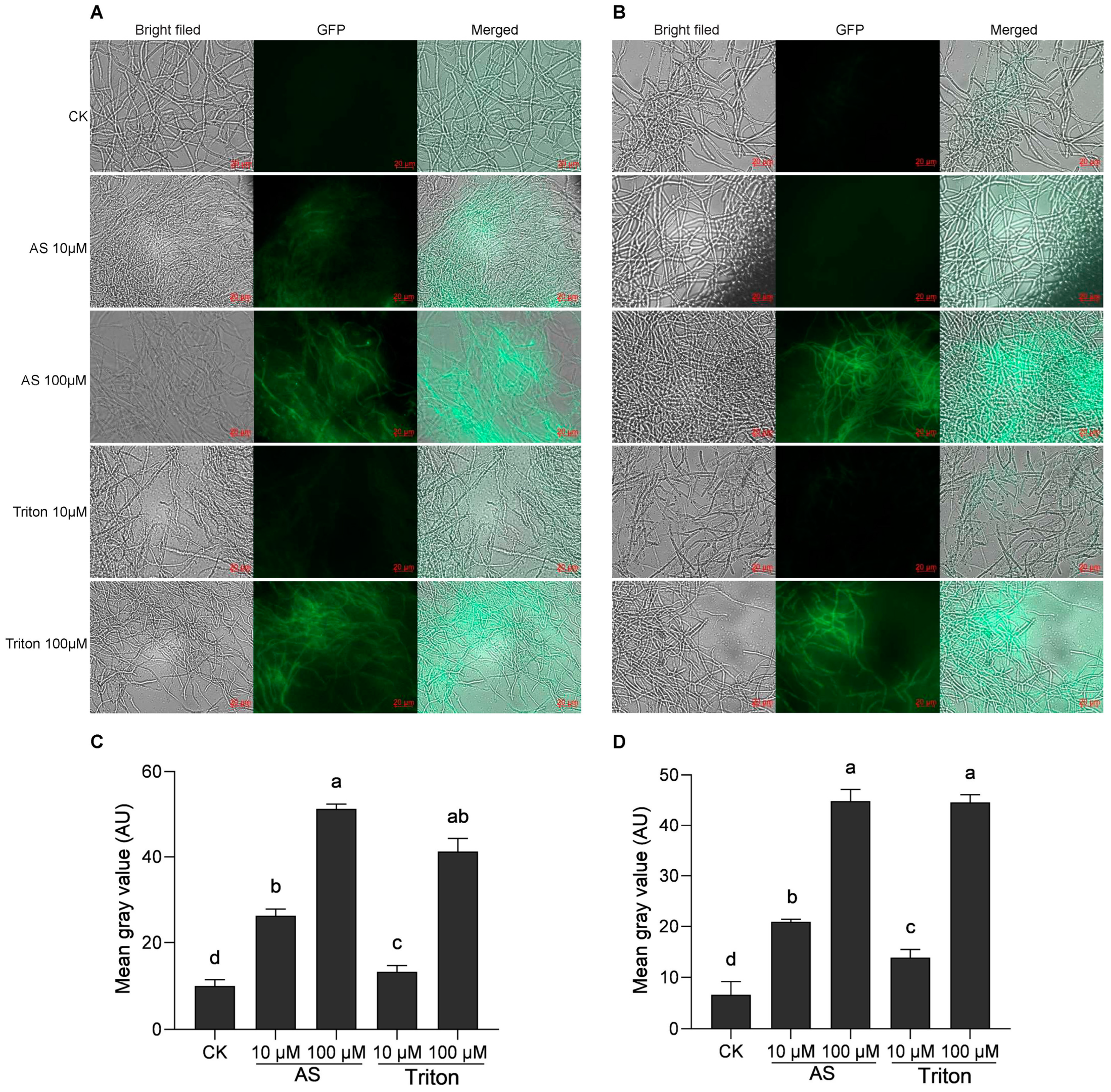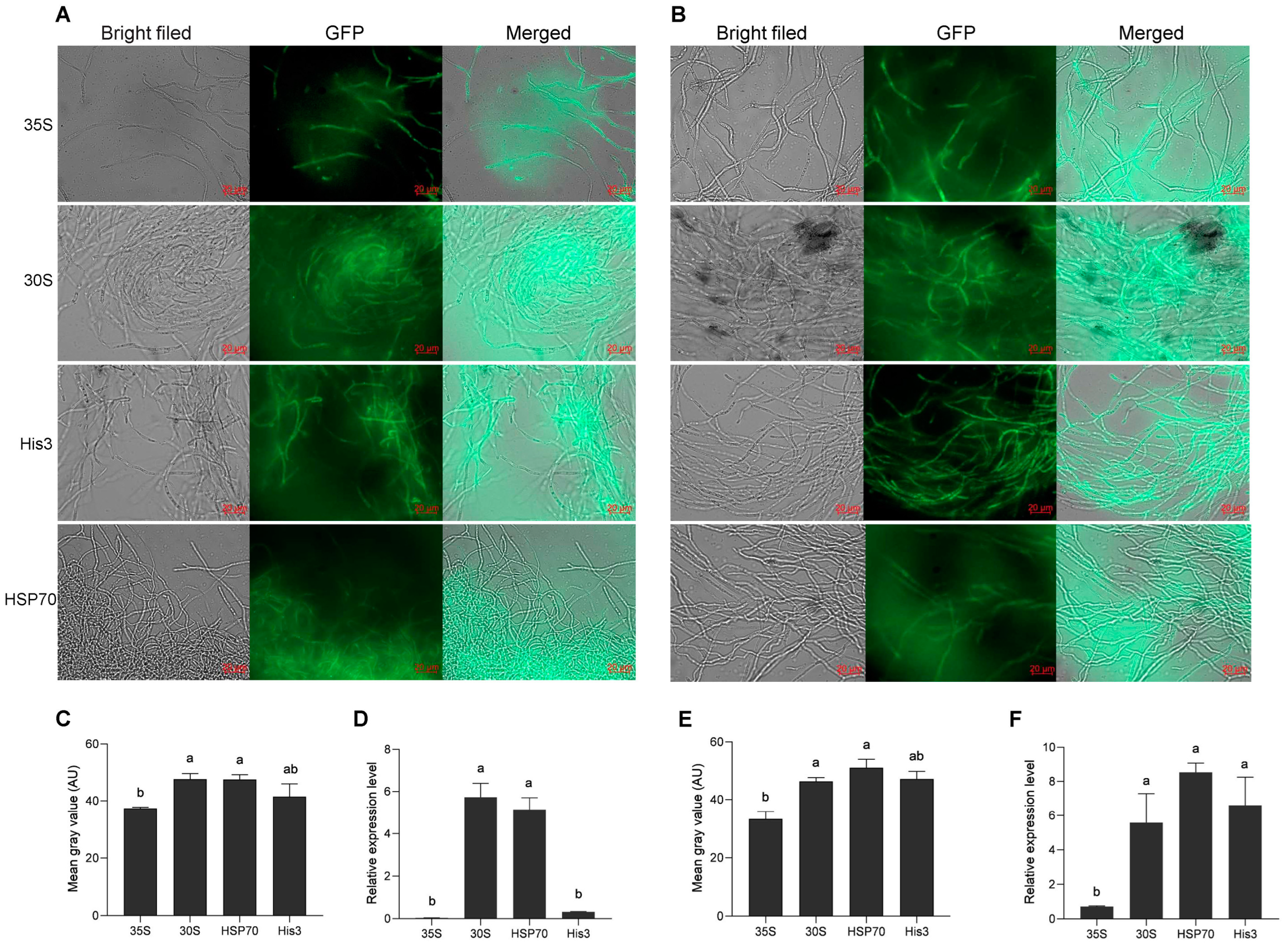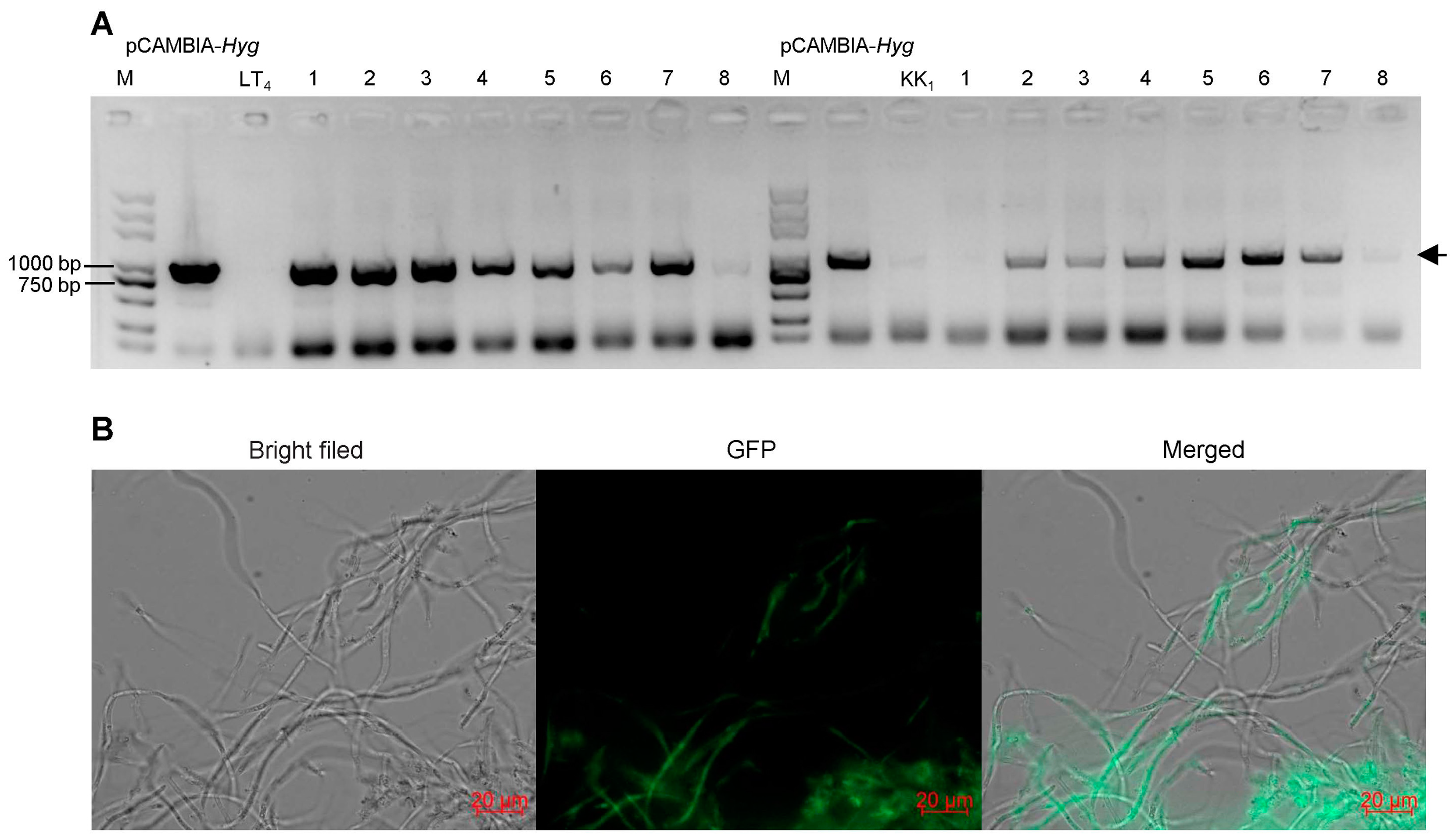Establishment of an Agrobacterium tumefaciens-Mediated Transformation System for Hirsutella sinensis
Abstract
1. Introduction
2. Materials and Methods
2.1. Experimental Strains
2.2. Culture Conditions
2.3. Screening of A. tumefaciens Strains and Inducers
2.4. Screening of Promoters
2.5. Optimizing ATMT for H. Sinensis
2.6. PCR Analysis of Transformants
2.7. RNA Extraction and Gene Expression Analysis
2.8. Detection of the Genetic Stability of Transformants
2.9. Statistical Analysis
3. Results
3.1. Screening of A. tumefaciens Strains
3.2. Effect of Inducers on Transformation Efficiency
3.3. Optimization of Promoters
3.4. Sensitivity of H. sinensis to the Hygromycin B Concentration
3.5. Optimization of ATMT Conditions
3.5.1. Effect of Coculture Time on Transformation Efficiency
3.5.2. Effect of Coculture Temperature on Transformation Efficiency
3.5.3. Effect of A. tumefaciens Concentration on Transformation Efficiency
3.5.4. Effect of Mycelial Passage Time on Transformation Efficiency
3.6. Stability of Transformants
4. Discussion
4.1. Establishment of ATMT for H. sinensis
4.2. Effects of Different A. tumefaciens Strains on ATMT in H. sinensis
4.3. Effects of Inducer Type and Concentration on ATMT in H. sinensis
4.4. Analysis of the Ability of Endogenous and Exogenous Promoters to Drive GFP Expression
4.5. Analysis of the Sensitivity of H. sinensis to Hygromycin B
4.6. Optimization of Other Factors Affecting ATMT in H. sinensis
5. Conclusions
Supplementary Materials
Author Contributions
Funding
Institutional Review Board Statement
Informed Consent Statement
Data Availability Statement
Acknowledgments
Conflicts of Interest
References
- Qin, Q.L.; Zhou, G.L.; Zhang, H.; Meng, Q.; Zhang, J.H.; Wang, H.T.; Miao, L.; Li, X. Obstacles and approaches in artificial cultivation of Chinese cordyceps. Mycology 2018, 9, 7–9. [Google Scholar] [CrossRef] [PubMed]
- Li, Z.Z.; Huang, B.; Li, C.R.; Fan, M.Z. Molecular evidence for anamorph determination of Cordyceps sinensis (BERK.) SACC. I. Relation between Hirsutella sinensis and C. sinensis. Mycosystema 2000, 19, 60–64. [Google Scholar]
- Shu, R.H.; Zhang, J.H.; Meng, Q.; Zhang, H.; Zhou, G.L.; Li, M.M.; Wu, P.P.; Zhao, Y.N.; Chen, C.; Qin, Q.L. A new high-quality draft genome assembly of the Chinese cordyceps Ophiocordyceps sinensis. Genome Biol. Evol. 2020, 12, 1074–1079. [Google Scholar] [CrossRef] [PubMed]
- Liu, J.; Guo, L.N.; Li, Z.W.; Zhou, Z.; Li, Z.; Li, Q.; Bo, X.C.; Wang, S.Q.; Wang, J.L.; Ma, S.C.; et al. Genomic analyses reveal evolutionary and geologic context for the plateau fungus Ophiocordyceps sinensis. Chin. Med. 2020, 15, 107. [Google Scholar] [CrossRef]
- Jin, L.Q.; Xu, Z.W.; Zhang, B.; Yi, M.; Weng, C.Y.; Lin, S.; Wu, H.; Qin, X.T.; Xu, F.; Teng, Y.; et al. Genome sequencing and analysis of fungus Hirsutella sinensis isolated from Ophiocordyceps sinensis. AMB Express 2020, 10, 105. [Google Scholar] [CrossRef]
- Xia, E.H.; Yang, D.R.; Jiang, J.J.; Zhang, Q.J.; Liu, Y.; Liu, Y.L.; Zhang, Y.; Zhang, H.B.; Shi, C.; Tong, Y.; et al. The caterpillar fungus, Ophiocordyceps sinensis, genome provides insights into highland adaptation of fungal pathogenicity. Sci. Rep. 2017, 7, 1806. [Google Scholar] [CrossRef] [PubMed]
- Yue, P.; Zhang, H.; Tong, X.X.; Peng, T.; Tang, P.; Gao, T.H.; Guo, J.L. Genome-wide identification and expression profiling of the MAPK, MAPKK, and MAPKKK gene families in Ophiocordyceps sinensis. Gene 2022, 807, 145930. [Google Scholar] [CrossRef]
- Xu, Z.X.; Zhu, Y.G.; Xuan, L.Y.; Li, S.; Cheng, Z. Haplotype diversity of NADPH-cytochrome P450 reductase gene of Ophiocordyceps sinensis and the effect on fungal infection in host insects. Microorganisms 2020, 8, E968. [Google Scholar] [CrossRef]
- Jin, L.Q.; Xu, Z.W.; Men, X.H.; Zhang, B.; Liu, Z.Q.; Zheng, Y.G. Enhancement of protoplast preparation and regeneration of Hirsutella sinensis based on process optimization. Biotechnol. Lett. 2020, 42, 2357–2366. [Google Scholar] [CrossRef]
- Xu, Z.W. The Breeding of Hirsutella sinensis with High Yield of Nucleosides and the Expression of Key Enzyme Genes. Master’s Thesis, Zhejiang University of Technology, Hangzhou, China, 2020. [Google Scholar]
- Michielse, C.; Hooykaas, J.P.; van den Hondel, J.J.C.; Ram, F.J.A. Agrobacterium-mediated transformation of the filamentous fungus Aspergillus awamori. Nat. Protoc. 2008, 3, 1671–1678. [Google Scholar] [CrossRef]
- Han, G.M.; Shao, Q.; Li, C.P.; Zhao, K.; Jiang, L.; Fan, J.; Jiang, H.Y.; Tao, F. An efficient Agrobacterium-mediated transformation method for aflatoxin generation fungus Aspergillus flavus. J. Microbiol. 2018, 56, 356–364. [Google Scholar] [CrossRef] [PubMed]
- Dong, Y.H.; Wang, S.T. Agrobacterium tumefaciens-mediated transformation method for Fusarium oxysporum. Methods Mol. Biol. 2022, 2391, 63–73. [Google Scholar] [PubMed]
- Thai, H.D.; Do, L.T.B.X.; Nguyen, X.T.; Vu, T.X.; Tran, H.T.T.; Nguyen, H.Q.; Tran, V.T. A newly constructed Agrobacterium-mediated transformation system based on the hisB auxotrophic marker for genetic manipulation in Aspergillus niger. Arch. Microbiol. 2023, 205, 183. [Google Scholar] [CrossRef] [PubMed]
- Prostak, S.M.; Medina, E.M.; Kalinka, E.; Lillian, K.F.L. A guide to Agrobacterium-mediated transformation of the chytrid fungus Spizellomyces punctatus. Access Microbiol. 2023, 5, 2516–8290. [Google Scholar] [CrossRef] [PubMed]
- Michielse, C.B.; Hooykaas, P.J.J.; van den Hondel, C.A.M.J.J.; Ram, A.F.J. Agrobacterium-mediated transformation as a tool for functional genomics in fungi. Curr. Genet. 2005, 48, 1–17. [Google Scholar] [CrossRef] [PubMed]
- Yan, L.L.; Xu, R.P.; Zhou, Y.; Gong, Y.H.; Dai, S.H.; Liu, H.Y.; Bian, Y.B. Effects of medium composition and genetic background on Agrobacterium-mediated transformation efficiency of Lentinula edodes. Genes 2019, 10, 467. [Google Scholar] [CrossRef]
- He, S.; Wang, S.; Luo, J.; Li, F.; Jin, X.; Wen, Z.; Ma, F.; Zhou, Z.; Tang, D. The re-study for morphology of Ophiocordyceps sinensis and Hirsutella sinensis. Microbiol. China 2011, 38, 1730–1738. [Google Scholar]
- Wang, J.F.; Zhong, W.; Wu, H.X. Screening of high sporulation strains of Hirsutella sinensis. Subtrop. Agric. Res. 2019, 15, 132–137. [Google Scholar]
- Ren, W.Q.; Wang, C.Y.; Zhao, R.; Li, H.H.; Zhang, Q.H.; Cai, D. Artificial cordyceps mycelium by submerged fermentation of Hirsutella sinensis HS 1201 using rice bran hydrolysate as substrate. Environ. Qual. Manag. 2021, 31, 109–118. [Google Scholar] [CrossRef]
- Jensen, E.C. Quantitative analysis of histological staining and fluorescence using ImageJ. Anat Rec. 2013, 296, 378–381. [Google Scholar] [CrossRef]
- Livak, K.J.; Schmittgen, T.D. Analysis of relative gene expression data using Real-Time quantitative PCR and the 2−ΔΔCt method. Methods 2001, 25, 402–408. [Google Scholar] [CrossRef] [PubMed]
- Li, B.; Gao, Y.; Mao, H.Y.; Borkovich, K.A.; Ouyang, S.Q. The SNARE protein Fol-Vam7 mediates intracellular trafficking to regulate conidiogenesis and pathogenicity in Fusarium oxysporum f. sp. lycopersici. Environ. Microbiol. 2019, 21, 2696–2706. [Google Scholar] [CrossRef] [PubMed]
- Zhang, Y.; Zhang, J.; Gao, J.; Zhang, G.; Yu, Y.; Zhou, H.; Chen, W.; Zhao, J. The colonization process of sunflower by a green fluorescent protein-tagged isolate of Verticillium dahliae and its seed transmission. Plant Dis. 2018, 102, 1772–1778. [Google Scholar] [CrossRef]
- Zhao, Z.; Li, W.S. Influence of different strains on Agrobacterium tumefaciens-mediated transformation efficiency of Trichoderma harzianum. North. Horticult. 2006, 3, 14–15. [Google Scholar]
- Sun, C.B.; Kong, Q.L.; Xu, W.S. Efficient transformation of Penicillium chrysogenum mediated by Agrobacterium tumefaciens LBA4404 for cloning of Vitreo scilla hemoglobin gene. Electron. J. Biotechnol. 2002, 5, 9–10. [Google Scholar] [CrossRef][Green Version]
- Liu, Y.; Ayibaota, T.; Guo, N.; Liu, Z.; Zhang, B.; Zhu, Q.; Gu, A. Optimization of Agrobacterium tumefaciens-mediated transformation system for Fusarium oxysporum. Microbiol. China 2021, 48, 2991–3001. [Google Scholar]
- Yan, Y.Q.; Hu, T.H.; Wang, W.H.; Hu, H.J.; Wei, Q.Z.; Wang, J.L.; Bao, C.L. Establishing of the transformation system of Fusarium oxysporum f. sp. melongenae by Agrobacterium tumefaciens-mediated transformation (ATMT) and constructing of GFP labeled strain. J. Agric. Biotechnol. 2023, 31, 1980–1988. [Google Scholar]
- Musa, M.; Jan, F.G.; Hamayun, M.; Jan, G.; Khan, S.A.; Rehman, G.; Ali, S.; Lee, I.J. An endophytic fungal isolate Paecilomyces lilacinus produces bioactive secondary metabolites and promotes growth of Solanum lycopersicum under heavy metal stress. Agronomy 2023, 13, 883. [Google Scholar] [CrossRef]
- Zhou, M.F. Effects of Surfactants on Laccase Production and Phenol Degradation by Penicillium succinis in Solid Fermentation. Master’s Thesis, Hunan University, Changsha, China, 2013. [Google Scholar]
- Jia, N.N.; Zhai, L.F.; Bai, Q.; Chen, X.R.; Wang, C.X.; Hong, N.; Wang, G.P. Marking of Valsa pyri with GFP and observing the infection and extension of marked strains in pear leaf tissues. J. Fruit Sci. 2015, 32, 1195–1200. [Google Scholar]
- Peng, C.B.; Chen, M.X.; Wei, R.F.; Sun, Y.; Zhang, C.K.; Liu, W. Isolation and identification of anthrax from tea plant and establishment of genetic transformation system. Southwest China J. Agric. Sci. 2021, 34, 2167–2173. [Google Scholar]
- Yoo, S.Y.; Bomblies, K.; Yoo, S.K.; Yang, J.W.; Choi, M.S.; Lee, J.S.; Weigel, D.; Ahn, J.H. The 35S promoter used in a selectable marker gene of a plant transformation vector affects the expression of the transgene. Planta 2005, 221, 523–530. [Google Scholar] [CrossRef] [PubMed]
- Somssich, M. A short history of the CaMV 35S promoter. PeerJ 2019, 7, e27096v3. [Google Scholar]
- Wang, C.; Lin, M.X.; Yang, Z.L.; Lu, X.Y.; Liu, Y.F.; Lu, H.Z.; Zhu, J.; Sun, X.M.; Gu, Y. Characterization of the endogenous promoters in Yarrowia lipolytica for the biomanufacturing applications. Process Biochem. 2023, 124, 245–252. [Google Scholar] [CrossRef]
- Hou, J.N.; Li, W.; Yang, X.J.; Sun, Y.; Xie, D.Y.; Wang, M.M.; Fang, W.P.; Zhao, F.A. Transformation of green fluorescent protein in Fusarium oxysporum of cotton. Mol. Plant Breed. 2019, 17, 3247–3252. [Google Scholar]
- Sørensen, L.Q.; Lysøe, E.; Larsen, J.E.; Khorsand-Jamal, P.; Nielsen, K.F.; Frandsen, R.J.N. Genetic transformation of Fusarium avenaceum by Agrobacterium tumefaciens-mediated transformation and the development of a USER-Brick vector construction system. BMC Mol. Biol. 2014, 15, 15. [Google Scholar] [CrossRef]
- Bao, D.; Huang, Z.; Li, Y.; Zhou, C.; Wan, J.; Tang, L.; Mao, W.; Wang, Y.; Gong, M.; Zou, G.; et al. Agrobacterium-mediated transformation of arthroconidia obtained from the edible mushroom Hypsizygus marmoreus. J. Microbiol. Methods 2020, 171, 105878. [Google Scholar] [CrossRef]
- Zhang, J.J.; Shi, L.; Chen, H.; Sun, Y.Q.; Zhao, M.W.; Ren, A.; Chen, M.J.; Wang, H.; Feng, Z.Y. An efficient Agrobacterium-mediated transformation method for the edible mushroom Hypsizygus marmoreus. Microbiol. Res. 2014, 169, 741–748. [Google Scholar] [CrossRef] [PubMed]
- Combier, J.P.; Melayah, D.; Raffier, C. Agrobacterium tumefaciens-mediated transformation as a tool for insertional mutagenesis in the symbiotic ectomycorrhizal fungus Hebeloma cylindrosporum. FEMS Microbiol. Lett. 2003, 220, 141–148. [Google Scholar] [CrossRef]
- Shi, L.; Fang, X.; Li, M.J.; Mu, D.S.; Ren, A.; Tan, Q.; Zhao, M.W. Development of a simple and efficient transformation system for the basidiomycetous medicinal fungus Ganoderma lucidum. World J. Microb. Biot. 2012, 28, 283–291. [Google Scholar] [CrossRef]
- Li, Z.M.; Ji, X.; Yuan, C.M.; Ma, S.Q. Bioactivity of Ganoderma lucidum and optimization of mycelial fermentation conditions. BIO Web Conf. 2023, 61, 01016. [Google Scholar] [CrossRef]
- Li, J.; Wu, M.; Igarashi, Y.; Luo, F.; Chang, P. Agrobacterium tumefaciens-mediated transformation of the white-rot fungus Dichomitus squalens. J. Microbiol. Methods 2023, 214, 106842. [Google Scholar] [CrossRef] [PubMed]






Disclaimer/Publisher’s Note: The statements, opinions and data contained in all publications are solely those of the individual author(s) and contributor(s) and not of MDPI and/or the editor(s). MDPI and/or the editor(s) disclaim responsibility for any injury to people or property resulting from any ideas, methods, instructions or products referred to in the content. |
© 2024 by the authors. Licensee MDPI, Basel, Switzerland. This article is an open access article distributed under the terms and conditions of the Creative Commons Attribution (CC BY) license (https://creativecommons.org/licenses/by/4.0/).
Share and Cite
Wu, L.; Hu, X.; Yan, S.; Wu, Z.; Tang, X.; Xie, L.; Qiu, Y.; Li, R.; Chen, J.; Tian, M. Establishment of an Agrobacterium tumefaciens-Mediated Transformation System for Hirsutella sinensis. Curr. Issues Mol. Biol. 2024, 46, 10618-10632. https://doi.org/10.3390/cimb46090629
Wu L, Hu X, Yan S, Wu Z, Tang X, Xie L, Qiu Y, Li R, Chen J, Tian M. Establishment of an Agrobacterium tumefaciens-Mediated Transformation System for Hirsutella sinensis. Current Issues in Molecular Biology. 2024; 46(9):10618-10632. https://doi.org/10.3390/cimb46090629
Chicago/Turabian StyleWu, Lijuan, Xinkun Hu, Shen Yan, Zenglin Wu, Xuzhong Tang, Lei Xie, Yujie Qiu, Rui Li, Ji Chen, and Mengliang Tian. 2024. "Establishment of an Agrobacterium tumefaciens-Mediated Transformation System for Hirsutella sinensis" Current Issues in Molecular Biology 46, no. 9: 10618-10632. https://doi.org/10.3390/cimb46090629
APA StyleWu, L., Hu, X., Yan, S., Wu, Z., Tang, X., Xie, L., Qiu, Y., Li, R., Chen, J., & Tian, M. (2024). Establishment of an Agrobacterium tumefaciens-Mediated Transformation System for Hirsutella sinensis. Current Issues in Molecular Biology, 46(9), 10618-10632. https://doi.org/10.3390/cimb46090629





